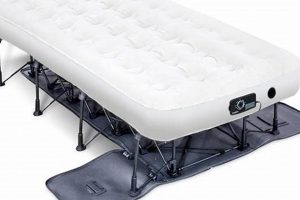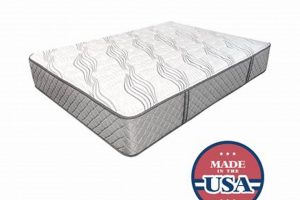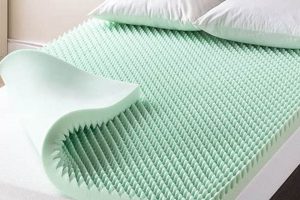The central question revolves around the capacity of a sport utility vehicle to accommodate a standard double bed mattress. This inquiry frequently arises during relocation, furniture purchases, or situations requiring temporary transport of sleeping arrangements. Measuring approximately 54 inches wide and 75 inches long, a mattress of this type presents a substantial volume to consider when assessing vehicle compatibility.
Understanding internal dimensions is crucial. Successfully transporting oversized items in a personal vehicle can offer significant cost savings compared to professional moving services. Moreover, it provides immediate control and flexibility in managing personal belongings. Historically, individuals have relied on creative strategies, including vehicle modifications and careful packing techniques, to overcome spatial limitations.
The following sections will explore factors influencing the feasibility of transporting such an item within different SUV models, provide methods for accurate measurement, and offer alternative solutions when direct transport proves impractical.
Transportation Strategies for a Standard Double Bed Mattress in an SUV
Optimizing space and ensuring safe transport are critical when attempting to fit a standard double bed mattress within a sport utility vehicle. Careful planning and execution can mitigate potential damage to both the vehicle and the mattress.
Tip 1: Measure the Mattress and Vehicle Interior: Accurately determine the dimensions of the mattress and the available cargo space within the SUV. Account for any obstructions, such as wheel wells or protruding fixtures. Compare the measurements to ascertain if the mattress can be accommodated, even at an angle.
Tip 2: Fold or Compress the Mattress (If Applicable): Some mattresses, particularly foam models, can be temporarily folded or compressed. Utilize straps or rope to secure the compressed form, reducing its overall volume. Consult the manufacturer’s guidelines to avoid damaging the internal structure.
Tip 3: Remove Interior Obstacles: Remove any removable seats, cargo covers, or other interior components that might impede loading. Maximize available space by creating a clear pathway for the mattress.
Tip 4: Protect the Mattress: Enclose the mattress in a protective cover, such as a mattress bag or heavy-duty plastic sheeting. This safeguards against dirt, moisture, and potential tears during transit.
Tip 5: Employ Proper Lifting Techniques: Use proper lifting techniques to avoid strain or injury. Enlist assistance when lifting and maneuvering the mattress. Lift with the legs, keeping the back straight, and avoid twisting motions.
Tip 6: Secure the Mattress: Once loaded, use straps or rope to securely fasten the mattress within the SUV. Prevent shifting during transit, as movement can damage the mattress or pose a safety hazard.
Tip 7: Plan the Route: Choose a route that minimizes sharp turns, sudden stops, and rough terrain. Smooth, direct paths reduce the risk of shifting or damage during transport.
Adhering to these guidelines significantly increases the likelihood of successfully and safely transporting a standard double bed mattress in a sport utility vehicle. Prioritization of measurement, protection, and securement are key to a favorable outcome.
Consideration of alternative transport options, such as professional moving services or mattress delivery, may be necessary if these strategies prove insufficient for a particular vehicle or situation.
1. Vehicle Cargo Dimensions
Vehicle cargo dimensions are the primary determinant of whether a standard double bed mattress can be transported inside a sport utility vehicle. The interior space’s length, width, and height dictate the maximum object size that can be accommodated. Insufficient cargo space renders transport impossible without external modification or alternative transport methods. A direct causal relationship exists: larger internal dimensions increase the probability of fitting the mattress, while smaller dimensions decrease it.
Understanding vehicle cargo dimensions is essential for pre-transportation planning. Accurate measurement of the available space allows for a comparative assessment against the mattress dimensions (approximately 54 inches wide and 75 inches long). For example, a compact SUV, such as a Honda CR-V, might offer a cargo depth of approximately 40 inches with the rear seats up, clearly insufficient for the mattress’s length. Conversely, a larger SUV, such as a Chevrolet Suburban, provides a cargo depth exceeding 75 inches with the rear seats folded, potentially accommodating the mattress horizontally. Failure to accurately assess these dimensions may result in wasted effort, potential vehicle damage, or the need for last-minute alternative arrangements.
In conclusion, the relationship between vehicle cargo dimensions and mattress size is fundamental to the feasibility of SUV transport. Accurate measurement and comparison are crucial for successful planning and execution. Limited cargo dimensions necessitate alternative strategies, such as professional moving services, to mitigate potential complications. Ignoring this critical aspect will most likely lead to transport challenges.
2. Mattress Overall Size
The physical dimensions of a standard double bed mattress are a critical factor determining transport feasibility within a sport utility vehicle. The mattress’s length, width, and thickness must be evaluated against the available cargo space in the vehicle. Discrepancies between these measurements will directly impact the success or failure of the transportation attempt.
- Length and Width as Limiting Factors
The length (typically 75 inches) and width (approximately 54 inches) of a standard double bed mattress represent the primary spatial constraints. If either dimension exceeds the corresponding dimension within the SUV’s cargo area, direct horizontal placement is impossible. This necessitates alternative loading strategies, such as diagonal placement, folding (if feasible), or external transport options. For instance, if an SUV’s cargo width is only 48 inches, the 54-inch mattress cannot be placed flat without obstruction.
- Thickness and Vertical Clearance
While length and width are typically the initial concern, mattress thickness can also pose challenges. A particularly thick mattress may reduce vertical clearance within the SUV, hindering the ability to close the rear hatch or gate. This is especially pertinent in SUVs with sloped rooflines or limited cargo height. The mattress’s thickness may also limit the ability to transport other items alongside it, further complicating the logistics.
- Material Composition and Flexibility
The composition of the mattress significantly impacts its overall size and transportability. Mattresses constructed primarily of foam may exhibit greater flexibility and compressibility compared to innerspring models. This allows for temporary folding or compression, reducing the overall volume and increasing the likelihood of fitting within the SUV. Conversely, rigid innerspring mattresses retain their shape and size, requiring a cargo area that closely matches their dimensions.
- Impact on Vehicle Handling
The mattress’s size, coupled with its weight, affects vehicle handling during transport. An oversized or excessively heavy mattress can alter the vehicle’s center of gravity, potentially compromising stability and maneuverability. This is especially relevant when navigating sharp turns or uneven road surfaces. Careful consideration of weight distribution and securement is essential to maintain safe driving conditions.
In summation, the precise dimensions and material characteristics of a standard double bed mattress are inherently linked to its transportability within an SUV. Overlooking any of these elements can lead to logistical difficulties and potential safety concerns. Accurate measurement and assessment are crucial for determining the most appropriate and effective transportation strategy. Mattress dimension should always be checked and carefully considered.
3. Folding/Compression Potential
The ability to fold or compress a standard double bed mattress significantly influences the feasibility of transporting it within a sport utility vehicle. This characteristic is not uniform across all mattress types, and its presence or absence directly affects the spatial demands and logistical considerations of the transport process.
- Foam Mattress Compressibility
Mattresses primarily composed of foam, such as memory foam or latex, exhibit a higher degree of compressibility than traditional innerspring models. This allows for temporary volume reduction through folding or rolling, potentially enabling accommodation within the SUV’s cargo area. The extent of compression depends on foam density and thickness; higher-density foams may resist compression more than low-density varieties. Careful compression, secured with straps, minimizes the space occupied. However, prolonged compression might affect the mattress’s long-term integrity and is not generally recommended.
- Innerspring Mattress Limitations
In contrast, innerspring mattresses possess limited folding or compression potential. The internal spring system resists deformation, making substantial volume reduction impractical. Attempting to force folding or compression can damage the spring structure, compromising the mattress’s support and comfort. While minimal bending might be possible, it is generally inadvisable due to the risk of irreversible damage. Consequently, innerspring mattresses necessitate cargo dimensions that closely match their uncompressed size.
- Hybrid Mattress Considerations
Hybrid mattresses, combining foam layers with an innerspring core, present a mixed scenario. The foam component allows for some degree of compression, but the presence of the innerspring unit limits the extent of volume reduction. The specific folding/compression potential depends on the relative proportion of foam and springs, as well as the overall mattress construction. Careful assessment of the hybrid’s structure is required to determine the feasibility of temporary folding for transport purposes.
- Potential for Damage
Irrespective of the mattress type, excessive or improper folding/compression can lead to damage. Creasing, tearing, or deformation of the mattress materials can compromise its structural integrity and comfort. In the case of innerspring mattresses, forcing compression can permanently damage the springs. It is therefore crucial to consult the manufacturer’s guidelines before attempting to fold or compress a mattress. If uncertainty exists, professional moving services should be considered to mitigate the risk of damage.
The folding/compression potential of a standard double bed mattress is a key factor governing its transportability within an SUV. Foam mattresses offer greater flexibility, while innerspring models present significant limitations. However, careful assessment of the mattress type, structure, and potential for damage is paramount before attempting to fold or compress it for transport. If compression is determined to be feasible, proper techniques and securement methods are essential to minimize the risk of damage during transit, impacting the “will a full size mattress fit in an suv” scenario.
4. Loading Access Points
The geometry and dimensions of the vehicle’s entry points are integral to the question of whether a standard double bed mattress can be accommodated within its cargo area. The available opening sizes dictate the ease and, at times, the possibility of maneuvering a bulky item such as a mattress into the vehicle’s interior.
- Rear Hatch/Liftgate Dimensions
The height and width of the rear hatch or liftgate opening constitute a primary constraint. If the mattress exceeds either of these dimensions, vertical or horizontal loading will be impeded. Some SUV models feature wider or taller hatch openings than others, directly influencing mattress compatibility. For example, an SUV with a narrow, sloped rear hatch may prevent loading the mattress in an upright position, even if the cargo area is sufficiently deep.
- Rear Door Aperture Size
In certain SUV designs, the rear door openings may offer an alternative loading pathway. However, the size and shape of these apertures can be limiting. The presence of wheel wells, seatbelts, or other interior protrusions may further restrict the available space. Attempting to force a mattress through a narrow door opening can result in damage to both the mattress and the vehicle’s interior trim.
- Interior Obstructions Near Access Points
Even if the initial opening appears adequate, internal obstructions near the loading points can hinder maneuverability. These obstructions may include fixed seating components, center consoles, or protruding trim panels. Carefully assessing these potential impediments is crucial before attempting to load the mattress. Removing removable obstructions can sometimes alleviate the problem, but fixed elements may necessitate alternative loading strategies or transport methods.
- Loading Angle and Maneuverability
The angle at which the mattress can be presented to the loading access point influences the likelihood of successful insertion. A wider loading angle provides greater flexibility in maneuvering the mattress, particularly in situations where the opening dimensions are only marginally larger than the mattress itself. Limited maneuverability, caused by tight spaces or internal obstructions, can necessitate more complex loading techniques or render the attempt unfeasible. Considering the available space for angling and rotating the mattress is therefore vital.
The configuration and dimensions of loading access points are inextricably linked to the successful transport of a standard double bed mattress in an SUV. Adequate opening sizes, minimal internal obstructions, and sufficient maneuverability are prerequisites for a successful loading outcome. Failure to consider these factors may result in logistical challenges, potential damage, or the ultimate inability to accommodate the mattress within the vehicle.
5. Securement Methods
The ability to effectively secure a standard double bed mattress within an SUV is fundamentally connected to the success and safety of its transportation. Even if the mattress physically fits within the vehicle’s cargo area, inadequate securement can lead to shifting during transit, resulting in damage to the mattress, the vehicle’s interior, or, in extreme cases, posing a hazard to the vehicle’s occupants and other drivers. The relationship is causal: insufficient securement directly increases the risk of adverse outcomes, while robust securement mitigates these risks. For instance, a mattress placed loosely in the back of an SUV can slide forward during braking, obstructing the driver’s view and potentially causing an accident.
Various securement methods are available, each with varying degrees of effectiveness. Ratchet straps, when properly applied to anchor points within the vehicle, provide a high level of stability, preventing both lateral and longitudinal movement of the mattress. Ropes, while less sophisticated, can also be used effectively if tied with secure knots and tensioned appropriately. Elastic bungee cords are generally unsuitable for securing heavy items like mattresses, as their elasticity allows for excessive movement. The choice of securement method should be dictated by the weight and dimensions of the mattress, the availability of suitable anchor points within the vehicle, and the anticipated driving conditions. The consequences of selecting inadequate securement can be demonstrated by scenarios involving sudden stops or sharp turns, where a poorly secured mattress may shift violently, causing damage or posing a safety risk.
In summary, securement methods are not merely an ancillary consideration but an integral component of the “will a full size mattress fit in an suv” equation. The suitability of a vehicle for transporting a mattress is not solely determined by physical fit but also by the availability of effective securement options. Prioritizing proper securement techniques is essential to ensuring a safe and successful transportation outcome, mitigating potential risks to both property and personal safety. Neglecting securement protocols increases the probability of unfavorable incidents during transit, irrespective of whether the mattress seems to fit at the start of the journey.
6. Internal Obstructions
Internal obstructions within a sport utility vehicle directly influence the feasibility of transporting a standard double bed mattress. These obstructions, inherent to the vehicle’s design, reduce usable cargo space, thereby impacting the ability to accommodate the mattress. The presence and severity of these obstructions are key elements in determining if a successful transport is possible. For example, protruding wheel wells significantly narrow the cargo floor, reducing the effective width available for the mattress. Similarly, fixed seating components, even when folded down, may not create a perfectly flat surface, leading to unusable gaps or requiring the mattress to be positioned at an angle, increasing its overall footprint. The design of the rear tailgate and associated mechanisms can also intrude into the cargo area, limiting the vertical space available. Therefore, an accurate assessment of internal obstructions is paramount when evaluating the transport of oversized items.
The impact of internal obstructions is further compounded by the mattress’s dimensions and rigidity. An innerspring mattress, with its inherent lack of flexibility, is particularly susceptible to the effects of internal obstructions. It cannot conform to uneven surfaces or navigate narrow spaces, necessitating a more precise match between its dimensions and the available cargo space. Conversely, a foam mattress may offer some degree of flexibility, allowing it to be compressed or contoured around minor obstructions. However, even with a flexible mattress, significant obstructions will impede loading and securement, potentially compromising the safety and stability of the load. Practical application of this understanding involves meticulous measurement of the cargo area, accounting for all obstructions, and comparing these measurements to the mattress’s dimensions. It may also necessitate creative packing strategies, such as using padding to fill gaps or strategically orienting the mattress to minimize the impact of obstructions.
In conclusion, internal obstructions serve as critical constraints in the successful transport of a standard double bed mattress within an SUV. Their presence reduces usable space and necessitates careful consideration of loading strategies and securement methods. Recognizing the significance of these obstructions and implementing appropriate mitigation measures are essential for a safe and efficient transport process. Failure to adequately address internal obstructions may result in damage to the mattress, the vehicle, or, in worst-case scenarios, compromise the safety of the occupants. Therefore, a thorough evaluation of internal obstructions is an indispensable step in determining whether a standard double bed mattress will indeed fit within a specific SUV model.
7. Weight Distribution
Proper weight distribution is paramount when considering transporting a standard double bed mattress in a sport utility vehicle. Even if the mattress physically fits, inappropriate weight distribution can compromise vehicle handling and safety, undermining the feasibility of the transport operation.
- Impact on Vehicle Stability
Uneven weight distribution can significantly alter a vehicle’s center of gravity, potentially leading to instability, particularly during cornering or braking. Placing the mattress solely on one side of the cargo area, or positioning it far towards the rear, concentrates weight and shifts the vehicle’s balance. This can result in reduced traction on certain wheels and increased susceptibility to rollovers or loss of control. Equalizing the weight across the vehicle’s axles and sides minimizes these risks and maintains a more predictable and stable driving experience. An example of this would be if the mattress is loaded on one side only, and you encounter a sharp turn, the vehicle could be prone to tipping.
- Effects on Suspension and Tires
Excessive weight, especially when concentrated in a single area, can overstress the vehicle’s suspension system and tires. Overloading the rear axle, for instance, compresses the rear suspension components beyond their design limits, potentially causing damage. It also increases the risk of tire blowouts, particularly at high speeds or on hot pavement. Distributing the mattress’s weight evenly across the vehicle’s axles helps to alleviate stress on individual components and maintain optimal tire contact with the road surface. Always check the weight capacity of the tires and the vehicle.
- Influence on Braking Performance
Weight distribution directly affects braking performance. Uneven weight distribution can lead to inconsistent braking forces across the wheels, resulting in longer stopping distances and increased risk of skidding. Weight shifting during braking can further exacerbate these issues, particularly if the mattress is not adequately secured. Maintaining a balanced weight distribution allows the anti-lock braking system (ABS) to function effectively and provides more predictable and controlled stopping power. If the mattress shifts forward under braking, the front brakes may lock up. Always ensure cargo is secured to prevent shifts.
- Considerations for Vehicle Payload Capacity
Every vehicle has a maximum payload capacity, which includes the weight of passengers, cargo, and any aftermarket accessories. Exceeding this limit can compromise safety and damage the vehicle. Before transporting a mattress, it is crucial to determine the vehicle’s payload capacity (typically found on a sticker inside the driver’s side door) and to calculate the combined weight of the mattress and any other items being transported. Failure to stay within the payload limit can lead to suspension damage, tire failure, and reduced braking performance, making transporting the mattress unsafe. It is essential to consider all additional weight and not exceed the specified limit.
In conclusion, assessing the weight distribution implications is crucial in conjunction with evaluating whether a standard double bed mattress can physically fit within an SUV. Proper weight distribution is not merely a matter of convenience but a fundamental safety consideration that directly impacts vehicle stability, suspension, braking performance, and overall handling. Ignoring these aspects can negate the feasibility of transporting the mattress, even if it initially appears to fit, due to the increased risks associated with compromised vehicle performance.
Frequently Asked Questions
The following questions address common concerns regarding the feasibility of transporting a standard double bed mattress within a sport utility vehicle.
Question 1: Are all SUVs equally capable of accommodating a standard double bed mattress?
No. Vehicle cargo dimensions vary significantly across SUV models. Compact SUVs generally offer less cargo space compared to mid-size or full-size SUVs. The internal dimensions must be carefully evaluated against the mattress dimensions to determine compatibility.
Question 2: Can a standard double bed mattress be folded without causing damage?
The feasibility of folding a mattress depends on its construction. Foam mattresses generally exhibit greater flexibility than innerspring models. Attempting to fold an innerspring mattress can damage the spring system. Consult the manufacturer’s guidelines before attempting to fold any mattress.
Question 3: What is the recommended method for securing a mattress within an SUV?
Ratchet straps are recommended for securing a mattress. These straps provide a high level of stability and prevent shifting during transit. Ensure the straps are properly tensioned and attached to secure anchor points within the vehicle.
Question 4: Does mattress weight impact vehicle handling and safety?
Yes. Excessive weight, particularly when unevenly distributed, can compromise vehicle handling and braking performance. Distribute the mattress’s weight evenly across the vehicle’s axles and avoid exceeding the vehicle’s payload capacity.
Question 5: What are the potential consequences of failing to properly secure a mattress during transport?
Failure to secure a mattress can result in shifting during transit, causing damage to the mattress or the vehicle’s interior. In severe cases, an unsecured mattress can pose a safety hazard to the vehicle’s occupants and other drivers.
Question 6: When should alternative transport methods be considered?
Alternative transport methods, such as professional moving services or mattress delivery, should be considered when the mattress dimensions exceed the SUV’s cargo capacity, when securement is problematic, or when concerns exist regarding vehicle handling and safety.
Proper planning, accurate measurement, and adherence to safety guidelines are essential for successful mattress transport within a sport utility vehicle.
This FAQ section provides answers to common questions, further sections will explore alternative solutions when direct transport in an SUV is not viable.
Assessing the Feasibility of Mattress Transport in an SUV
The preceding analysis has exhaustively explored the multifaceted considerations governing whether a full size mattress fit in an suv. Key factors encompass vehicle cargo dimensions, mattress overall size and compressibility, loading access points, effective securement methods, the presence of internal obstructions, and the critical importance of weight distribution. A thorough evaluation of these elements is essential for determining the viability of transporting a mattress using a particular sport utility vehicle.
Ultimately, the decision to transport a mattress via SUV requires a pragmatic assessment of spatial constraints, vehicle capabilities, and safety protocols. Prudence dictates prioritizing safety and minimizing the risk of damage to both the mattress and the vehicle. When doubts arise concerning any of the aforementioned factors, alternative transport solutions, such as professional movers or dedicated delivery services, warrant serious consideration to ensure a successful and risk-free outcome.



![Best Full Size Mattress Foundation [Guide] Organic & Natural Mattress Buyer’s Guide: Non-Toxic Sleep Solutions Best Full Size Mattress Foundation [Guide] | Organic & Natural Mattress Buyer’s Guide: Non-Toxic Sleep Solutions](https://mattressworldpa.com/wp-content/uploads/2025/07/th-2811-300x200.jpg)
![Best Full Size Loft Bed Mattress [Guide] for Comfort Organic & Natural Mattress Buyer’s Guide: Non-Toxic Sleep Solutions Best Full Size Loft Bed Mattress [Guide] for Comfort | Organic & Natural Mattress Buyer’s Guide: Non-Toxic Sleep Solutions](https://mattressworldpa.com/wp-content/uploads/2025/07/th-2810-300x200.jpg)


